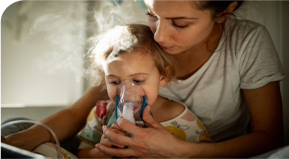Lung disease is still the 3rd leading cause of death in the world
better treatments are needed
Important challenges in lung delivery
How to improve delivery times of nebulized medications?
Patients taking inhaled antibiotics face a grueling medical regimen which can include long sessions, often twice daily, on nebulizer-based treatments, a burden associated with significant decline in quality of life.
How to improve convenience/ease of use for the patient?
Standard nebulizers require multiple assembly & disassembly steps and involved cleaning regimens, especially when sterilization of parts is needed.
How to improve adherence and outcomes?
The burden of long nebulization times has been shown to result in low adherence rates. And poor adherence has been associated with poor outcomes.
How to improve precision and efficiency of delivery?
Advanced treatments are in development that due to their complexity and high cost will require more precision and higher delivery efficiency to be cost effective.
Gilbert’s solutions for patients
Patients with serious lung infections can spend up to 70-90 minutes a day on time-consuming nebulizer-based treatments, a burden associated with poor adherence and a significant decline in quality of life. Gilbert envisions to reduce this burden by developing a more patient friendly delivery system.

Delivery times can be reduced through higher efficiency and breath-actuated dosing.

Convenience can be improved if assembly and cleaning steps are simplified.

Adherence can be enhanced with dosing reminders and dose tracking supports.
Experts’ opinions

Prof. P.N.Richard Dekhuijzen
EM. Professor of Pulmonology,
University Lung Center Nijmegen,
Expert Board ADMIT
EHDA technology has the potential to offer unique benefits to patients for aerosolization and medication targeting of advanced molecular entities for respiratory diseases and for pulmonary administration of molecules for other indication areas.

Wim Vos
MSc, PhD,
Chief Executive Officer RADIOMICS
Gilbert’s EHDA technology is one of the most promising innovations in device inhalation technology, offering substantial advantages to patients compared to current commercial available inhalation technology solutions.
Main therapeutic applications
Gilbert is focused on treating respiratory diseases with significant unmet medical needs, like fibrotic diseases such as cystic fibrosis, and severe asthma among others, diseases where we believe our electrospray technology can bring unique benefits.
01
Cystic Fibrosis (CF)
CF is a progressive and fatal genetic disease in which daily therapies to maintain lung health are critical, yet treatment adherence is low.
02
Severe Asthma
Asthma is a heterogeneous lung disease affecting an estimated 339 million people worldwide, and approximately 10% of asthma patients have severe asthma.
Our proposition for Pharma, Biotech & Academia
Our proposition
From first feasibility to clinical trials our R&D team will work with you to investigate how our electrospray platform can optimize the aerosolization of your formulations for the most efficient and targeted pulmonary delivery.
Redefining treatment for lung patients.
Want to know more?